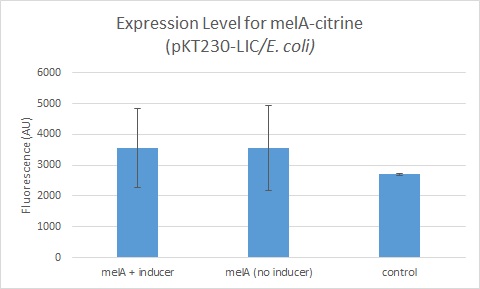Difference between revisions of "Part:BBa K1856000"
Jinchentian (Talk | contribs) |
Jinchentian (Talk | contribs) |
||
| Line 1: | Line 1: | ||
__NOTOC__ | __NOTOC__ | ||
<partinfo>BBa_K1856000 short</partinfo> | <partinfo>BBa_K1856000 short</partinfo> | ||
| − | |||
| − | |||
| − | + | bacA promoter assembled to citrine and T7 terminator | |
| + | |||
===Usage and Biology=== | ===Usage and Biology=== | ||
| + | bacA is an inducible promoter native to rhizobium species (notably R. tropici and S. meliloti) that is induced by flavonoids. This construct has been successfully cloned into E. coli using the broad-host range vector pKT230, a RSF1010 derived plasmid. Leaky expression of citrine was observed. | ||
| − | + | The construct has also been cloned into S. meliloti. | |
| − | + | ||
| − | + | ||
| Line 17: | Line 15: | ||
<!-- --> | <!-- --> | ||
| − | |||
| − | |||
| − | |||
| − | |||
==Characterization== | ==Characterization== | ||
| − | [[Image: | + | [[Image:Expression_Level_for_melA-citrine_(pKT230-Lic).jpg|300px|right]] |
===Measured strengths=== | ===Measured strengths=== | ||
| − | + | Leaky expression of BacA was observed See part [https://parts.igem.org/Part:BBa_J61002 J61002] for details on their use. | |
==Obtaining the Anderson promoter collection== | ==Obtaining the Anderson promoter collection== | ||
[[Image:Expression_Level_for_melA-citrine_%28pKT230-Lic%29.jpg|right|150px|right]] | [[Image:Expression_Level_for_melA-citrine_%28pKT230-Lic%29.jpg|right|150px|right]] | ||
| − | The sequences of | + | The sequences of construct can be found via the table below. The physical DNA can be obtained from: |
| − | '''Via | + | |
| + | '''Via request''': The Yale iGEM team has the promoter cloned | ||
'''Via the Registry distribution''': The promoters are included in the Registry distribution. All parts except <partinfo>J23119</partinfo> are present in plasmid <partinfo>J61002</partinfo>. This places the RFP downstream of the promoter. Part <partinfo>J23119</partinfo> is present in <partinfo>pSB1A2</partinfo>. | '''Via the Registry distribution''': The promoters are included in the Registry distribution. All parts except <partinfo>J23119</partinfo> are present in plasmid <partinfo>J61002</partinfo>. This places the RFP downstream of the promoter. Part <partinfo>J23119</partinfo> is present in <partinfo>pSB1A2</partinfo>. | ||
<br style="clear:both" /> | <br style="clear:both" /> | ||
| + | |||
| + | <!-- --> | ||
| + | <span class='h3bb'>Sequence and Features</span> | ||
| + | <partinfo>BBa_K1856000 SequenceAndFeatures</partinfo> | ||
Revision as of 22:36, 20 September 2015
bacA-citrine-T7 terminator
bacA promoter assembled to citrine and T7 terminator
Usage and Biology
bacA is an inducible promoter native to rhizobium species (notably R. tropici and S. meliloti) that is induced by flavonoids. This construct has been successfully cloned into E. coli using the broad-host range vector pKT230, a RSF1010 derived plasmid. Leaky expression of citrine was observed.
The construct has also been cloned into S. meliloti.
Characterization
Measured strengths
Leaky expression of BacA was observed See part J61002 for details on their use.
Obtaining the Anderson promoter collection
The sequences of construct can be found via the table below. The physical DNA can be obtained from:
Via request: The Yale iGEM team has the promoter cloned
Via the Registry distribution: The promoters are included in the Registry distribution. All parts except BBa_J23119 are present in plasmid BBa_J61002. This places the RFP downstream of the promoter. Part BBa_J23119 is present in pSB1A2.
Sequence and Features
- 10INCOMPATIBLE WITH RFC[10]Illegal EcoRI site found at 920
- 12INCOMPATIBLE WITH RFC[12]Illegal EcoRI site found at 920
Illegal NotI site found at 945 - 21INCOMPATIBLE WITH RFC[21]Illegal EcoRI site found at 920
Illegal BamHI site found at 914
Illegal XhoI site found at 954 - 23INCOMPATIBLE WITH RFC[23]Illegal EcoRI site found at 920
- 25INCOMPATIBLE WITH RFC[25]Illegal EcoRI site found at 920
- 1000COMPATIBLE WITH RFC[1000]

